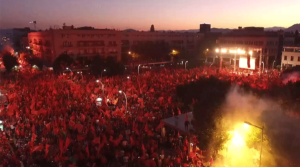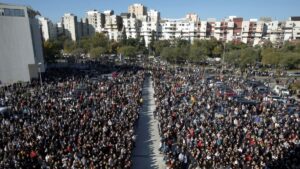
PODGORICA, 10.12.2020. – The coronavirus pandemic globally brought a ban on mass rallies as one of the main changes because they were the largest incubator of the infection at the start. The most famous example is the football match between Italian Atalanta and Spanish Valencia on February 19 this year in Milan, which, among other things, later turned the Italian city of Bergamo black, from which 40,000 fans or every third inhabitant of that city arrived to support Atalanta in Milan. Pictures of military trucks transporting corpses from Bergamo to other cities because they do not manage to bury them, traveled the world and were a cruel lesson.
And yet, despite that, there is probably no smaller country that had more mass gatherings than Montenegro at the time of the epidemic. This is one of the main reasons why Montenegro in 5 months has gone from a European champion in the fight against the coronavirus to a country that is at the top of all statistics in the world in the number of patients. The epidemic was ignited by almost everyone with irresponsible behavior – citizens, believers, the Serbian Orthodox Church (SPC) in Montenegro, the government and the opposition, which in the meantime has become the new government. All this, in one way or another, was covered by the Montenegrin media, including digital or portals.
An analysis of Montenegrin portals’ reporting on high-risk and officially banned mass rallies shows that they mostly reported inconsistently on these events, in line with their political preferences. The bias is reflected in the fact that most of the most influential portals kept silent about the violation of measures against coronavirus when the gatherings were organized by their political or church favorites, while in other situations they strongly criticized the violation of those same measures.
The first large mass gathering during the epidemic was a liturgy on the occasion of religious holiday, a day of St. Vasilije of Ostrog on May 12 in Niksic, after which the police arrested the Bishop of Budva-Niksic Joanikije and eight other SPC priests on suspicion of violating measures against coronavirus. The portals here had different interpretations of the same event.
The Cafe del Montenegro (CDM) portal emphasizes in its report that “despite the ban on public gatherings, the Serbian Orthodox Church organized a liturgy in Niksic attended by many SPC supporters” and the Antena M radio portal that “a large number of people gathered who did not respect physical distance or wore protective masks”. The same was reported by the portal Analitika, the portal Pobjeda and the portal Radio – Television of Montenegro (RTCG).
Portal Vijesti stated that “a large number of citizens gathered at the liturgy in Niksic” and that “the ban on gatherings is still in force in Montenegro” and reported that “Joanikije welcomed the believers who kissed his hand and he gave them blessing” adding that Joanikije said “that they complied with all the measures prescribed by medicine.”
On the other hand, the IN4S and Borba portals, reporting on this event, do not mention the violation of measures against coronavirus or the ban on gatherings that was officially in force at the time, but IN4S states that the liturgy was “magnificent and unplanned” and emphasizes that “By arresting Joanikije, the regime crossed the line in the confrontation with Orthodoxy,” while Borba quotes Joanikije as saying that “some people did not understand well what the liturgy of St. Vasilije in Niksic meant to the people.”
The next series of mass rallies followed on the eve of the parliamentary elections on August 30, when the Serbian Orthodox Church and the Metropolitanate of Montenegro and the Littoral renewed their lithiums against the controversial Law on Freedom of Religion. The protests took place in several cities a few days before the elections, and then the gathering of up to 200 citizens was officially allowed. Montenegrin portals covered these rallies as well, but they did not problematize the fact that measures against coronavirus were violated at some of them because there were more than 200 people, which was easily visible in the recordings published by those portals themselves. This time, the portals focused on the messages from the gatherings themselves, which were not only religious, but also political, because the priests of the Serbian Orthodox Church themselves openly invited people to vote for the removal of the Democratic Party of Socialists (DPS).
After winning the elections, supporters of the opposition and the Serbian Orthodox Church celebrated two nights on the streets of Podgorica and in front of the Church of Christćs Resurrection. Then again, the measures against the coronavirus were violated because thousands of people gathered, but the portals again dealt more with the messages and iconography of the gatherings, failing to emphasize it or not considering it important. The Vijesti portal only stated in its text that “measures aimed at preventing the coronavirus, which concern the ban on public gatherings, the obligation to wear masks both indoors and outdoors, and to maintain social distance, are still in force.” The portals Pobjeda, Analitika, CDM, Antena M emphasized that “tricolors, Serbian flags and cockades were carried at the celebration, Chetnik songs were sung and Kosovo and Serbia were cheered on”. The Vijesti portal, on the other hand, estimated that “many more Montenegrin flags were seen on the second night of the celebration than this was the case on the first night”. As far as the text is concerned, the IN4S and Borba portals reported quite briefly from these gatherings but IN4S provided videos that once again confirmed the violation of the measures. Truth be told, almost no Montenegrin media in the first post-election days problematized this celebration from an epidemiological point of view.

It did not take long for new mass gatherings to happen. Montenegrin patriotic organizations, with the tacit consent of the then still ruling DPS, held patriotic rallies in Cetinje and Podgorica on September 3rd and 6th, protesting against the arrival of the new government. Measures were massively violated at these gatherings as well, both in terms of the number of allowed participants and in terms of the distance, which, of course, could not be maintained. Now, however, we have had the opposite media situation. The portals IN4S and Borba stated that these rallies were not reported to the police, and then accused the previous government of hypocrisy because it kept silent about the organization of patriotic rallies and accused the opposition and the Serbian Orthodox Church of spreading the coronavirus at their rallies.
On the other hand, RTCG portals; CDM, Analitika, Antena M and Pobjeda conveyed the main messages from the rallies, some of them calling them magnificent, but they did not problematize or even mention the violation of measures that was obvious, as they insisted during previous rallies organized by the SPC.
Portal Vijesti reminded again that public gatherings are limited to much fewer people than of the number present at these gatherings, but also that these measures have been massively violated before. They also stated that the prosecution had initiated proceedings against citizens and priests of the Metropolitanate of Montenegro and the Littoral on several occasions for violating measures against coronavirus, and that this was not the case after patriotic rallies, calling it “double standards”. “The police did not in any way interfere with the rally, which was indirectly supported by Prime Minister Dusko Markovic,” Vijesti wrote, which later tirelessly investigated who the people behind the organization of these patriotic rallies were.

Finally, the final epidemiological bomb followed the funeral and burial of the late Metropolitan of Montenegro and the Littoral, Amfilohije, from October 30 to November 1 in Cetinje. During all three days, mass violations of measures were recorded, and most of the portals covered all that. They published recordings of communion with the same spoon, kissing the dead body of Amfilohije who died as a result of the coronavirus, and stated that some representatives of the future government did not respect the measures and did not wear masks. “Warnings are in vain, priests and believers massively violate measures against the epidemic,” the portal Vijesti wrote, while Pobjeda, Analitika, CDM and Antena M conveyed the appeal “to close the open coffin with the body of Amfilohije” because, as doctor Nevenka Pavlicic, who asked for it, said “that religious ritual is a hotbed of infection”. The appeal was also conveyed by the IN4S portal, but they, as well as Borba, did not pay attention to the fact that the measures were being massively violated, but only repeated the appeals of the priests to respect the measures.
The coronavirus epidemic has changed the way of life and thus brought new challenges to the media in their work. However, the sharp polarization of the media in Montenegro has not disappeared but deepened even more, as shown by the way these rallies are reported. Although all portals made an effort to professionally cover all these events, the vast majority did not achieve complete professionalism because they inconsistently favored one side and kept silent about its omissions and sharply attacked the rival, accusing it of violating the measures. It seems that such fan practice will not change for a long time.
* This article is published within the program Union to Union 2020, financed by International federation of journalists.